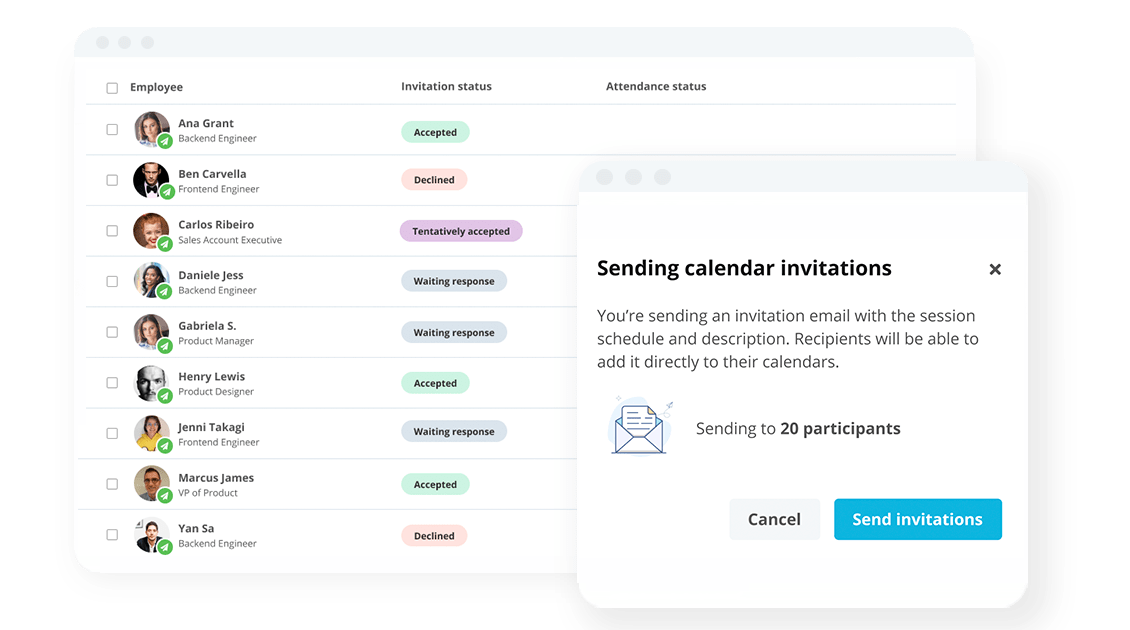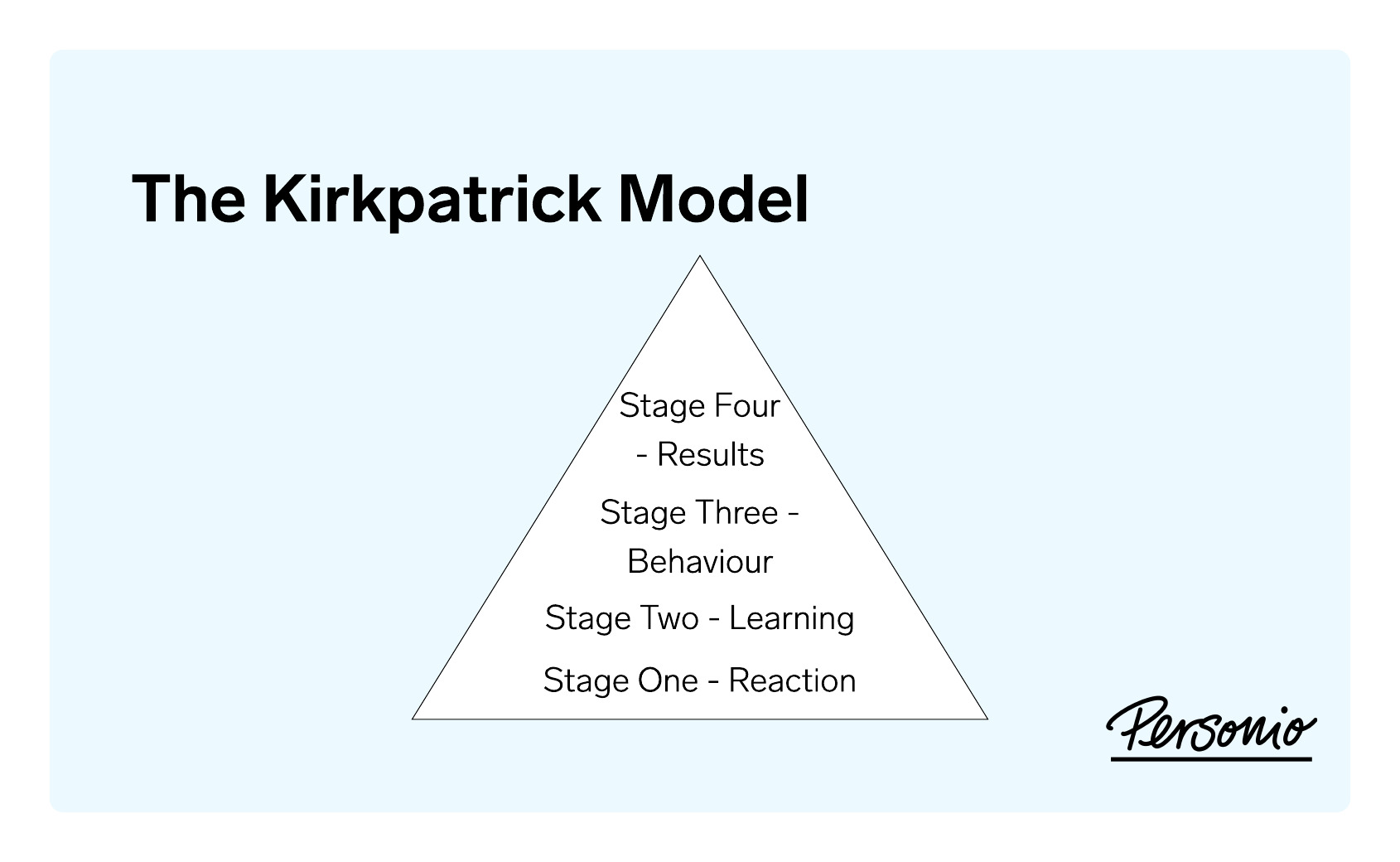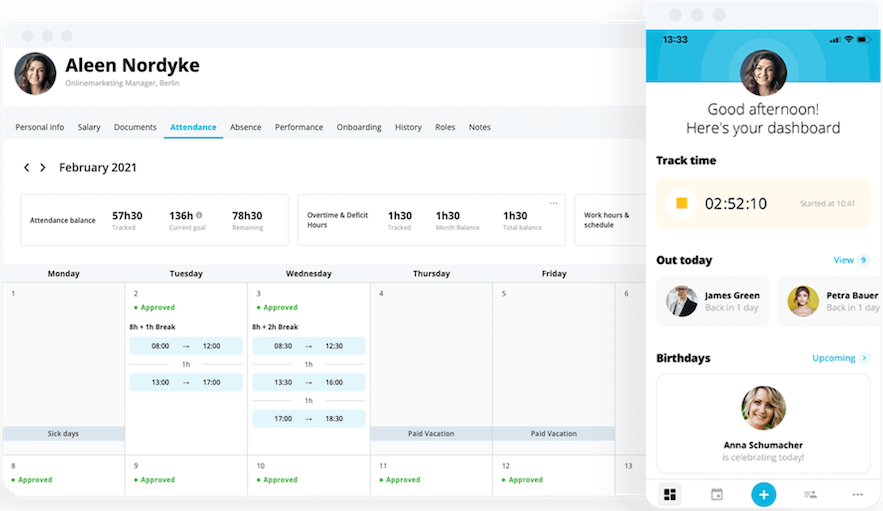
Give the Right Training at the Right Time
Simplify your staff development with centralised training management.
The Kirkpatrick Model: Four Unique Levels of Evaluation
The Kirkpatrick Model of Evaluation is easily the most popular and widely-used model for evaluating educational, training, and learning programs. Using it can help you ensure your trainings are impactful and effective.
In this article, you'll learn:
The four levels of the Kirkpatrick Model
How to use it to ensure learners gain new knowledge and skills
How to use it backwards to develop new trainings
And much more
Let's dive in.
Start from the top with our performance review template today.What is the Kirkpatrick Model of Evaluation?

The Kirkpatrick Model is an internationally recognised tool to evaluate and analyse the results of educational, training and learning programs. It is made up of four levels of evaluation: Reaction, Learning, Behaviour, and Results. The model is often visualised as a pyramid, where each successive level more precisely measures a program's effectiveness than the level before it.
In 1959, Donald Kirkpatrick, former Professor Emeritus at the University of Wisconsin, first introduced his model in a publication. He then updated it in 1975 and 1993 with his most widely-known publication, Evaluating Training Programs. Later on, the model was further developed by Donald and his son, James, and later with James' wife Wendy Kayser Kirkpatrick. The theory was eventually revised to be the "New World Kirkpatrick Model" which was added to their book, Four Levels of Training Evaluation.
What Are the Four Levels of the Kirkpatrick Evaluation Model?
The four levels of evaluation in the Kirkpatrick Evaluation Model are:
Reaction
Learning
Behaviour
Results.
Let's dive into each level in more detail.
Kirkpatrick Model Level One: Reaction
The first level involves documenting the learners' reaction to the training, with the goal of measuring how engaging, positive, and relevant they found the program. Identifying any key topics that may have been missing also enables you to make improvements for future trainings.
This level is most often assessed with a post-program survey asking learners to rate their experience in the training, but you can also evaluate Reaction by watching body language and soliciting verbal feedback.
One key aspect of evaluation level one is to keep the focus on the learner rather than the educator. Honing in on the learner's takeaways ensures the most relevant and actionable feedback possible. For example:
"Were the program objectives clearly defined?" becomes "How well did you understand the learning objectives?"
"Was the learning material relevant?" becomes "Will you be able to apply your learnings right away?"
"Did the trainer show a solid understanding of the material?" becomes "Was your learning strengthened by the knowledge of the trainer?"
Kirkpatrick Model Level Two: Learning
In level two, it's time to measure what the participants learned – or didn't learn – in the training program. The "New World Kirkpatrick Model" also adds to level two a measurement of what learners think they'll be able to do differently after the training, their level of confidence to do it, and their motivation to make those changes.
To evaluate whether participants gained the knowledge, skills, confidence, and motivation intended with the training, we can use pre- and post-learning assessment like exams and interview evaluations.
Evaluating this level should be objective, so you'll want to determine in advance what the scoring process will be and what results you'll be measuring. Identify the learning outcomes you want learners to achieve with your training, and test for those areas both before and after the program.
Develop Staff With Ease

Track training attendance, progress and compliance across your organisation from one central, easy-to-use tool.
Kirkpatrick Model Level Three: Behaviour
Level three measures changes to behaviour after the learning program. Were the learning objectives understood? Did they gain new skills? Is it possible for them to use those skills in the workplace (or other impacted area)?
Note that this level of evaluation can take time; learners may need weeks or months to build up their confidence and find opportunities to apply their new knowledge and skills.
There are a variety of ways to measure behaviour, and the ones you choose will be dependent on the type of training. Evaluation methods could include interviews, writing up observations of participants' actions, or providing opportunities (e.g. projects) that allow learners to apply the skills they've learned.
If a training doesn't affect how the learner behaves – i.e., if participants don't apply what they learned – it doesn't necessarily mean the training was ineffective. It could be placing a spotlight on issues in the environment, culture, and processes of your organisation. You'll need to evaluate further to ensure learning and positive change is encouraged.
Kirkpatrick Model Level Four: Results
Finally, it's time to measure the results of the training. This can be the most expensive and time-consuming level, but it's crucial to understand if the training achieved the outcomes your organisation wanted. In other words, was there a positive return on investment (ROI)?
The challenge is to decide which benefits or results can be closely tied to the educational program itself and to figure out how to measure those results long-term. Examples could include:
Increased sales or productivity
Increased employee retention
Higher customer satisfaction or ratings
Few complaints
Less waste
Etc.
How Do You Use the Kirkpatrick Model?
There are two main ways to use the Kirkpatrick Model of Evaluation:
In order – To evaluate and analyse a training that has already been developed, simply work your way through the four levels in order.
Backwards – These days, trainers will often use the Kirkpatrick Model backwards, especially when designing new trainings: they'll start by naming the results they want to achieve and then design the training to deliver those results. This is a more iterative process and ensures the development of the program is prioritising the right goals so it can be as effective as possible.
Kirkpatrick Model: Frequently Asked Questions (FAQ)
What are the Four Levels of the Kirkpatrick Model?
The four levels of the Kirkpatrick Model of Evaluation are Reaction, Learning, Behaviour, and Results.
Is the Kirkpatrick Model Effective?
The Kirkpatrick Model is generally considered an effective and reliable way for organisations to evaluate their trainings and educational programs. It is especially helpful when determining the ROI and other results of a training.
Like any model, it does have disadvantages: for example, it can be expensive and time-consuming, and it's not as helpful with making changes to a training while it is still ongoing.
Who Should Use the Kirkpatrick Model?
The Kirkpatrick Model can be used by any organisation that offers trainings and educational programs. According to Kirkpatrick Partners, the model "works in all sectors, such as government, military, corporate, consulting, services, and humanitarian."
Maximise the Impact of Your Training With Personio
Even if you design the perfect course and the results of your Kirkpatrick Model evaluation are 100% positive, you still need to ensure the right people actually complete the program.
That's where Personio’s training management software comes in. Easily track training attendance, progress and compliance across your organisation in one centralised, easy-to-use tool. Personio helps you ensure your employees get the L&D opportunities they need to learn new skills, grow in their role and prepare your business for the future.

